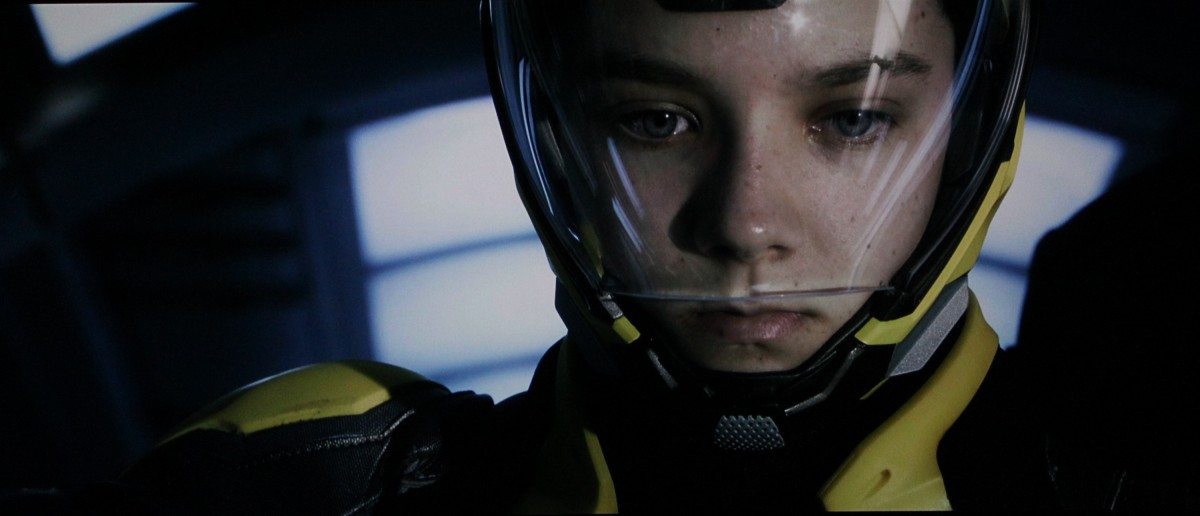JVC Firmware Update and Rec. 2020 Color Profile Software
The following 2 updates for the JVC projectors were released by JVC in late March 2016. New projectors now shipping to dealers include the latest firmware and may also have the Rec. 2020 color profile pre-installed (but I have not confirmed this latter item with JVC)
Firmware Update -
JVC has issued a firmware update for their current generation of home theater projectors. See item 3 on the JVC web page found HERE. In order to download the firmware update to your PC, you will need to provide your projector's serial number. The JVC firmware zip file includes both the firmware image file plus an installer program that must be run on a Windows PC. Also you will need to download the instructions for performing the update.
The PC/laptop must be connected to the projector via the serial communications (i.e., RS232C) port on the back of the projector. Since most modern PCs/laptops no longer have a serial comm. port, for this case you will need a USB-to-RS232 Serial Comm. Adapter. JVC has tested two such adapters and verified they work correctly with their projectors. These are the Tripp Lite Keyspan model USA-19HS and the Staples USB-Serial Adapter item number 837560. I successfully used the Staples adapter for updating the firmware in my DLA-RS600. Note Staples on-line store sells this adapter for about $20 but your local Staples store may be asking a higher price, but in that case they should agree to price-match their own on-line price.
You will also need a RS232 Serial Null-Modem Cable with female DB9 connectors at each end. I purchased a 10 foot long, Star-Tek brand cable from Amazon for under $5 - link is HERE.
Before starting the firmware update you should disconnect all cables from the projector, including the power cord and wait for all status light on the projector to turn off. Then connect the serial null-modem cable coming from the computer, to the serial comm. port on the projector, followed by reconnecting the power cord before starting the firmware update program on the connected PC.
Read the JVC provided firmware update instructions before you begin then be very careful to follow those instructions to perform the update. Not following these instructions "to the letter" could result in a "bricked" projector that might have to returned to JVC for repair. So take you time and be careful to follow the instructions and everything should go alright.
Rec. 2020 Color Profile Update -
The same JVC web page (HERE), as noted above for the firmware update, also includes under item 2 links for 3 addition downloads that are important for properly displaying 4K/UHD content from Ultra HD Blu-ray discs. First is software for a Rec. 2020, WCG, color profile. This new color profile can only be installed on the projector using the JVC Calibration program that is another of the 3 links on the JVC web page. Finally, a third link is provided to download the instructions for installing the new Rec. 2020 color profile in the projector.
For this update the Windows PC/laptop running the JVC Calibration software must be connected to the projector via a network connection. This can be either thru an wired Ethernet LAN connection or using a CAT5 or CAT6 cable directly between the PC and the network connector on the rear of the projector. Be certain to follow the JVC instructions carefully when adding the new color profile.
Picture Quaity/Performance with Ultra HD Blu-ray Discs
Ultra HD Blu-ray discs offer three areas of enhanced picture quality/performance as compared to standard 1080p HD Blu-ray discs. These are:
- 4K Resolution (i.e., 2160p)
- High Dynamic Range (HDR)
- Wide Color Gamut (WCG)
In the following 3 sections I address what the JVC setup needs to be and the performance/limitations of the projector in supporting each of these 3 capabilities.
4K/UHD Resolution -
The Ultra HD Blu-ray discs are capable of supporting up to the full UHD 3840 x 2160 resolution (frequently called 4K). However, not all movies being released on Ultra HD Blu-ray discs are able to take advantage of the full resolution this new disc format has to offer. For example, virtually all of the movies so far released by Fox Studio start off with Fox using a Digital Intermediate (DI) that only has 2K resolution then upscaling this to a 4K format before recording the movie on the Ultra HD Blu-ray disc. In some cases they may have inserted higher resolution camera footage for some scenes, shot at 3K or 4K, to replace the lower resolution version from the DI. This was said to the case for Ultra HD Blu-ray release of "The Martian". On the other hand some movie studios already have a number of their recent movies available that were shot with 4K and 5K cameras and have an existing DI in 4K resolution, that was previously used to produce the theatrical release of that movie. This is generally the case for the disc releases from Sony Pictures. So to sum it up, some discs offer full 4K resolution while others are upscaled 2K or a mixture of upscaled 2K and 4K scenes.
Currently among consumer projectors only Sony offers models with full 4K native resolution. The JVC pixel shifting technique, which JVC calls e-shift, as used on their "4K" projectors offers an actual displayed resolution that is better than regular 1080p HD, but falls short of full 4K resolution. I like to think of this as "4K lite", but even with this limitation the DLA-RS600 can project and impressively detailed image from a quality Ultra HD Blu-ray disc. With the best discs (with full 4K resolution) native 4K displays will show a little more fine details, but at a realistic viewing distance the difference, while visible, are generally rather subtle. In my home theater using a DLA-RS600, my first row seating is only approx. 9 feet from my 120 inch (diagonal) screen, thus the viewing distance is approximately equal to one screen width. I found that when playing Ultra HD Blu-rays, the image can appear extremely detailed, even with the limitations inherent with JVC's e-shift approach.
High Dynamic Range (HDR) -
JVC has included HDR compatibility in their currently home theater projectors. This is their first attempt at supporting this new video enhancement and the design for these projectors was finalized months before the first HDR enabled video sources actually become available. When the projectors detects the incoming video is in HDR format, as indicated by a 'flag' included in the data header on the HDMI data, the projector switches to the pre-set gamma 'D' mode and places the lamp in high mode. Also the auto iris (i.e., dynamic iris) is switched off.
When using these JVC factory default settings with a HDR encoded Ultra HD Blu-ray disc, the projected image appears very dark, as seen in the 1st screen shot photo below.
After JVC engineers were able to actually get there hands on an Ultra HD Blu-ray player and movies releases, they issued a set of suggested settings for their projectors to better display HDR content. There is a gamma sub-menu that allows the user to make detailed adjustments to the gamma curve. JVC now recommends using the following settings for these detailed adjustments for the Gamma 'D' setting:
| Gamma setting |
: |
D |
| Picture Tone |
: |
+12 |
| Dark Level |
: |
+5 |
| Bright Level |
: |
+4 |
The lamp should be set on high power mode to obtain maximum image brightness. The JVC full set of recommendations for displaying HDR content is under item 1 - HERE.
The 2nd photo above is using the JVC recommended settings for displaying a scene from the movie "Ender's Game" (i.e., HDR encoded disc)
However, no one projector setting will be ideal for all HDR discs. This is because the reference brightness levels for the peak HDR highlights is not fixed by the Ultra HD Blu-ray standard. Rather, the HDR encoded video is allowed to be graded for presentation on displays with a maximum brightness that ranges over a very wide range with the reference value used for the specific disc title indicated by a data field on encoded the disc. Thus making it possible for the disc player and/or the HDR display to compensate for the difference in the HDR reference level used on that specific disc vs. the actual brightness of the display being used. The initial Ultra HD Blu-ray movie releases have used HDR reference levels ranging from 1000 nits up to 4000 nits.
It appears that neither the Samsung UBD-K8500 disc player nor the JVC projectors are actually using the HDR reference level information to automatically adjust the image for the brightness. As a result, some user adjustments to the disc player's or the projector's controls may be necessary in order to obtain consistent image quality when going from one HDR disc to the next. The 3 alternatives for this are to adjust: (1) the projector's contrast control; (2) the projector's Picture Tone on the detailed gamma 'D' sub-menu; or (3) the Samsung player's Contrast picture adjustment. For me, I found using the projector's contrast control the most convenient. It appears the upcoming Panasonic Ultra HD Blu-ray player, already available in Europe, does use the HDR reference level information from the disc to apply some processing to the picture.
With my setup using a DLA-RS600 with a 120 inch (diagonal 16 x 9) screen with an actual gain of about 1.1, the peak DHR highlights are displayed with maximum of about 2 to 2.5 times the brightness of the non-HDR white levels. However, LCD/LED flat panel UHD TVs supporting HDR can typically display the HDR highlights at 8 to 10 times the brightness of the non-HDR whites. As a result, the impact of HDR on the picture is not going to be a great with a projector setup as compared to using a very bright UHD TV. Even with that limitation I found the impact of HDR was obvious with certain movies, such as 'Mad Max: Fury Road" which has lots of very bright explosions and other visual effects that take advantage of HDR. With certain other movies the impact of HDR was less obvious, except for occasional scenes.
While HDR can increase the visual impact of certain movies, it's not all good news for viewing HDR content on the JVC projector. This is, in part, because JVC has elected to lock out use of the automatic iris when in HDR more. In fact, the default HDR mode has the manual iris fully open and the lamp running in how power mode. While producing the brightest picture possible, it also produces an elevated black level and reduced contrast ratio, as compare to the settings most users would employ for viewing non-HDR content. We are still talking about a contrast ratio of a little over 30,000:1 in HDR mode with the DLA-RS600, but this is still a real step down from what's realistic with this projector with non-HDR content. I hope JVC will decide to enable the automatic iris in HDR mode through a future firmware update, but as it now stands viewing HDR content on this JVC projector involves some trade-offs.
Wide Color Gamut (WCG)
The DLA-RS600 supports DCI-P3 color gamut, which is more-or-less what is being used for the initial movie releases on Ultra HD Blu-ray discs. However the standard for the Ultra HD Blu-ray disc format encodes the color gamut within a 'container' defined by ITU Rec. 2020. As discussed above, JVC has now released software that adds a Rec. 2020 color profile to the projector.
I found that when using this new color profile for viewing Ultra HD Blu-ray discs, that are encoded for WCG, the results was generally a picture with more vivid colors, but without appearing unnatural. For some movie titles the difference was obvious, as compared to the more limited Rec. 709 color gamut used on standard HD Blu-ray discs. However, for other movies the impact was less obvious.
The Bottom Line
So what is the bottom line on viewing 4K/UHD content on the DLA-RS600?
Before summarizing my conclusions, I should mention that in addition to the dozen Ultra HD Blu-ray movie discs I have viewed, all of which are HDR encoded, I have also viewed several non-HDR movies in 4K resolution. This was using a hard disk drive, offered by Samsung, that can be plugged into the USB port on the front of the UBD-K8500 player. The hard drive came pre-loaded with 10 movies as well as number of short documentaries that can be accessed via the media player function in the UBD-K8500.
The DLA-RS600, while not capable of displaying quite all of the finest details present on the best 4K/UHD sources, comes close. While clearly a step up from a normal 1080p display, the e-shift approach falls a just little short of what's possible with a native 4K/UHD display. When viewed from a one screen width distance, the picture appears to reveal excellent detail when using a quality 4K source.
HDR is a mixed bag with both pluses and minuses when viewed on the DLA-RS600, as compared to non-HDR 4K content. For some movies with lots of bright highlights, HDR is effective at increasing the depth and impact of the image and I felt the benefits out weighted the negatives associated with the increased black levels and reduced contrast ratio. On other movies however, I found the benefits of HDR to be modest and I would rather of had the better black levels and superior contrast available from a non-HDR recording. Neither the Samsung UBD-K8500 nor the JVC DLA-RS600 offers a user option to disable HDR and force the processing that is needed to convert the HDR encoded video to Standard Dynamic Range (SDR). The Samsung player automatically does this conversion, but only when connected to a non-HDR capable display. Thus, it only outputs in HDR encoded video in HDR mode when connected to a HDR capable display. such as the DLA-RS600. It is my understanding that the new Panasonic Ultra HD Blu-ray player offers the user option to force the HDR to SDR conversion. The Panasonic player is expected to be available in the USA in the Sept. 2016 time frame while it is already available in Europe.
With the Rec. 2020 color profile installed on the DLA-RS600, the colors when playing Ultra HD Blu-ray discs, graded for Wide Color Gamut, looked very good. This provides for color saturation levels up to what you will see in the best commercial cinemas and the DLA-RS600 does a good job at bringing this capability to the home theater.



